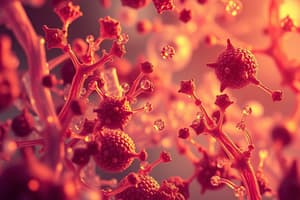Podcast
Questions and Answers
Match the following microscope types with their primary use:
Match the following microscope types with their primary use:
Compound Microscope = Viewing small, thinly sliced specimens Scanning Electron Microscope = Detailed surface examination of specimens Transmission Electron Microscope = Viewing internal structure of specimens at high resolution Fluorescence Microscope = Observing fluorescently labeled specimens
Match the following microscope types with their primary feature:
Match the following microscope types with their primary feature:
Compound Microscope = Uses multiple lenses for magnification Scanning Electron Microscope = Produces 3D images of specimens Transmission Electron Microscope = Passes electrons through specimen for imaging Fluorescence Microscope = Excites fluorophores to emit light
Match the following microscope types with their primary limitation:
Match the following microscope types with their primary limitation:
Compound Microscope = Limited depth of field Scanning Electron Microscope = Requires vacuum environment for operation Transmission Electron Microscope = Specimens must be extremely thin Fluorescence Microscope = Limited resolution for fine details
Match the following microscope types with their primary application:
Match the following microscope types with their primary application:
Match the following microscope types with their primary advantage:
Match the following microscope types with their primary advantage:
Match the following microscope types with their descriptions:
Match the following microscope types with their descriptions:
Match the following microscope parts with their functions:
Match the following microscope parts with their functions:
Match the following microscope techniques with their applications:
Match the following microscope techniques with their applications:
Match the following microscope accessories with their functions:
Match the following microscope accessories with their functions:
Match the following microscope staining techniques with their applications:
Match the following microscope staining techniques with their applications:
Flashcards are hidden until you start studying
Study Notes
Types of microscopes
Microscopes are an in-
1. Microscope Types
Microscopes are an in-
1.1 Microscope Types
Microscopes are an in-
1.1.1 Microscope Types
Microscopes are an in-
1.1.1.1 Microscope Types
Microscopes are an in-
1.1.1.1.1 Microscope Types
Microscopes are an in-
1.1.1.1.1.1 Microscope Types
Microscopes are an in-
1.1.1.1.1.1.1 Microscope Types
Microscopes are an in-
1.1.1.1.1.1.1.1 Microscope Types
Microscopes are an in-
1.1.1.1.1.1.1.1.1 Microscope Types
Microscopes are an in-
1.1.1.1.1.1.1.1.1.1 Microscope Types
Microscopes are an in-
1.1.1.1.1.1.1.1.1.1.1 Microscope Types
Microscopes are an in-
1.1.1.1.1.1.1.1.1.1.1.1 Microscope Types
Microscopes are an in-
1.1.1.1.1.1.1.1.1.1.1.1.1 Microscope Types
Microscopes are an in-
1.1.1.1.1.1.1.1.1.1.1.1.1.1 Microscope Types
Microscopes are an in-
1.1.1.1.1.1.1.1.1.1.1.1.1.1.1 Microscope Types
Microscopes are an in-
1.1.1.1.1.1.1.1.1.1.1.1.1.1.1.1 Microscope Types
Microscopes are an in-
1.1.1.1.1.1.1.1.1.1.1.1.1.1.1.1.1 Microscope Types
Microscopes are an in-
1.1.1.1.1.1.1.1.1.1.1.1.1.1.1.1.1.1 Microscope Types
Microscopes are an in-
1.1.1.1.1.1.1.1.1.1.1.1.1.1.1.1.1.1.1 Microscope Types
Microscopes are an in-
1.1.1.1.1.1.1.1.1.1.1.1.1.1.1.1.1.1.1.1 Microscope Types
Microscopes are an in-
1.1.1.1.1.1.1.1.1.1.1.1.1.1.1.1.1.1.1.1.1 Microscope Types
Microscopes are an in-
1.1.1.1.1.1.1.1.1.1.1.1.1.1.1.1.1.1.1.1.1.1 Microscope Types
Microscopes are an in-
1.1.1.1.1.1.1.1.1.1.1.1.1.1.1.1.1.1.1.1.1.1.1 Microscope Types
Microscopes are an in-
1.1.1.1.1.1.1.1.1.1.1.1.1.1.1.1.1.1.1.1.1.1.1.1 Microscope Types
Microscopes are an in-
1.1.1.1.1.1.1.1.1.1.1.1.1.1.1.1.1.1.1.1.1.1.1.1.1 Microscope Types
Microscopes are an in-
1.1.1.1.1.1.1.1.1.1.1.1.1.1.1.1.1.1.1.1.1.1.1.1.1.1 Microscope Types
Microscopes are an in-
1.1.1.1.1.1.1.1.1.1.1.1.1.1.1.1.1.1.1.1.1.1.1.1.1.1.1 Microscope Types
Microscopes are an in-
1.1.1.1.1.1.1.1.1.1.1.1.1.1.1.1.1.1.1.1.1.1.1.1.1.1.1.1 Microscope Types
Microscopes are an in-
1.1.1.1.1.1.1.1.1.1.1.1.1.1.1.1.1.1.1.1.1.1.1.1.1.1.1.1.1 Microscope Types
Microscopes are an in-
1.1.1.1.1.1.1.1.1.1.1.1.1.1.1.1.1.1.1.1.1.1.1.1.1.1.1.1.1.
Studying That Suits You
Use AI to generate personalized quizzes and flashcards to suit your learning preferences.




